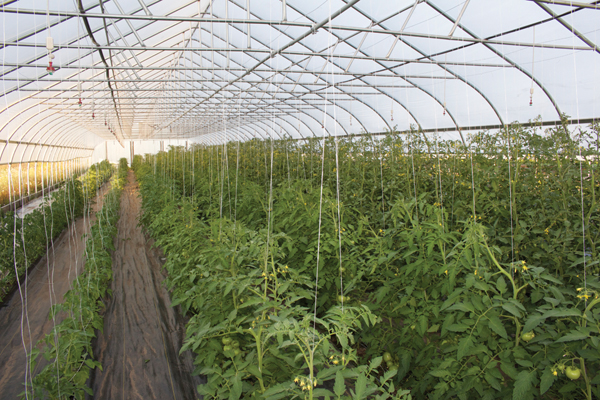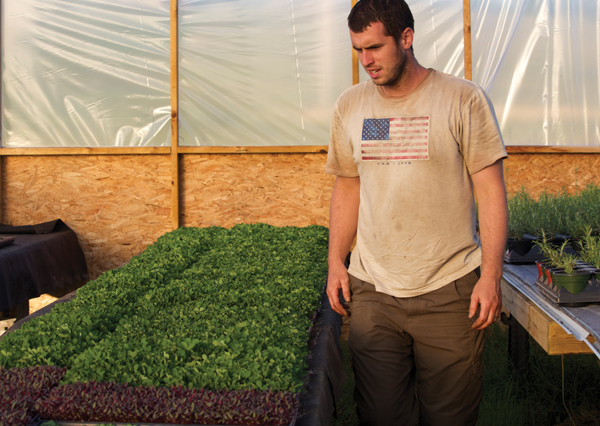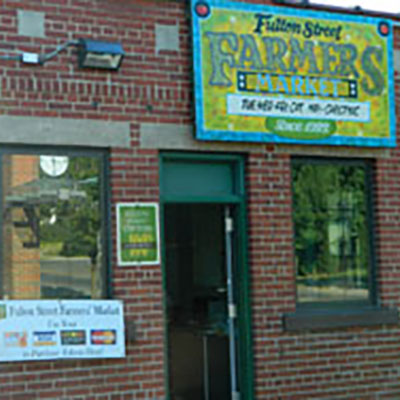
Two years ago, Brian and Anne Bates had just purchased 75 acres of land near Petoskey, Michigan, with a loan from their parents. They had no house, no barns, no structures of any kind other than a few beehives. Both were working full time jobs — Brian at the locally owned cooperative grocery store, and Anne as a teacher.
Today, they have a heated greenhouse and two unheated hoophouses, a building that does double duty as living quarters and packing house, a pole barn for meetings and workshops, a tractor and other equipment. They both stopped working off the farm. Their sales by early July were $50,000, and they were on track to break $100,000 this year.
To most people, that would seem to be an incredibly fast start to a small farm, but Brian sees it a bit differently.
“Everyone says we’ve had such a fast start, but it depends on when you say we started,” said Brian, who is 25 years old and a 2012 graduate of Penn State University. “I was very specifically trying to design the kind of farm I would like to have from the time I took my first Sustainable Ag class in college.”
To that end, Brian and Anne worked at and visited numerous farms, traveled to 40 states in search of a place where they would like to settle, explored diverse ideas including grain and livestock, attended countless conferences, and read everything they could lay their hands on to refine their plans.
Their startup story, whenever you start the clock on it, is a whirlwind of hard work, analytical thinking, bold financial moves, and relationship building. Brian and Anne often describe their business as a “full-transparency farm” and they willingly shared the details that might inspire others to jump-start a farming business.
Finding the right spot
Brian grew up in Virginia, Anne in Indiana. They met at a summer camp many years ago and maintained a long-distance relationship throughout college. Brian got a bachelor’s degree in geography with a minor in entomology, Anne a master’s in animation and new media. Once they decided they wanted to farm together, they agreed that it would be someplace in the north.
relationship throughout college. Brian got a bachelor’s degree in geography with a minor in entomology, Anne a master’s in animation and new media. Once they decided they wanted to farm together, they agreed that it would be someplace in the north.
“Climate change is real. Natural resource issues are real. We were smitten with Montana, but we ruled that out for water resource reasons,” Brian said. “In my junior year, I sent out applications for internships for every northern farm from Maine to Washington state. Coveyou Scenic Farm (in Petoskey, Michigan) called me back and offered me an internship. Then I came back a second year as the farm manager.
Above: Bear Creek devotes an entire 30 x 144 high tunnel to more than 1,000 tomatoes, which are pruned to a single leader and trellised. The second high tunnel is used for cucumbers and basil in summer. Winter greens are more important to the farm’s overall business, though, so both tunnels will be cleaned out and replanted in September.
“Every day we fell more in love with the area so we started looking for land. Our parents took us seriously and agreed to serve as the bank for us. We found 75 acres close to town and paid $2,000 an acre. My parents, who live outside of Washington, D.C., couldn’t believe how cheap land was. We actually could have found cheaper land, but this is close to town and we knew that, no matter what, we wanted to be close to town.
“We had visited 40 states in five years with the idea of finding the perfect place. We didn’t want to have that ‘grass is greener’ thing; we wanted to be very comfortable that this is where we want to live.”

Bear Creek Organic Farm, named for the township in which it is located, is 3.5 miles from Petoskey, a town on the Little Traverse Bay of Lake Michigan with a year-round population of 6,000 that grows many times larger with summer residents and tourists who come for the pleasant weather and beautiful scenery. From a grower’s perspective, Petoskey’s cool nights and long, sunny summer days (it’s north of the 45th parallel of latitude) make for excellent growing conditions. Fresh water is abundant, and the soil is a sandy loam well-suited to vegetable and fruit production.
Above: Brian Bates inspects microgreens almost ready for harvest. Behind him are the potted herbs he sells at markets and to retail stores. Below, a bench of microgreens at various stages, with peas and burgundy amaranth in front. The 30 x 72 heated greenhouse has already produced about $25,000 in sales this year.
Winter is another story at this latitude, of course, with average annual snowfall of 117 inches and an average low temperature in January of 15°F. But even the harsh winters were put to use in the business planning for Bear Creek Organic Farm.
Financing the farm
Besides the loan they got from their parents to buy the land, Brian and Anne have taken advantage of numerous grant and loan programs.
Their first was a loan for more than $30,000 from the Beginning Farmer micro loan program at USDA’s Farm Service Agency. They used it to build a 30 x 72 heated greenhouse; the kit was delivered in November 2013, which turned out to be the year they got 190 inches of snow. “We worked on it all through December and January but we finally had to quit until it warmed up,” Brian recalled. “When we got it done, it was Memorial Day, 2014, and we planted 10,000 starts that afternoon.”
They started going to farmers markets in June with nothing but herb plants and honey.
The second funding opportunity was the NRCS High Tunnel program, which gave them a grant of $9,474 to build a 30 x 144 unheated hoophouse. Next they went after and won a loan for a second hoophouse from a state program called Hoophouses for Health, which gave them a loan of $14,000 for a hoophouse, to be paid back over five years by accepting tokens at farmers markets from low-income families.
They applied for and won a Kiva Zip crowdfunded, no-interest micro loan of $10,000 that has to be paid back in 36 months.
Then USDA raised the lifetime limit on the FSA loan, so they got an additional $20,000 loan.
“All of the sudden we had built fifty grand in structures with $5,000 out of pocket and our highest interest rate was 1.8%,” Brian said. “I’m not afraid of debt. I don’t want too much, but I’m a firm believer that debt keeps you honest. We’re paying everything back out of farm income, so it’s on me to grow the business to justify that debt.”
The debt repayment comes to about $20,000 a year. Brian set a goal for himself of $60,000 in sales this year, with one-third to debt, one-third to his own salary, and one-third to operating costs.
“We realized shooting for $60,000 was way low and we needed to do more. So we talked about what can we sell, how can we generate cash.” Anne created cute notecards with illustrations of bees and a calendar with photos of the farm. Both sold out. They created a loyalty program — $10 for a reusable shopping bag with Anne’s illustrations that can be used at farmers markets for a 10% discount. They sold greens and herbs every week. By the end of March, with 3 feet of snow still on the ground, they already had $10,000 in revenue.
Finding a niche
“We said from the get-go that we wanted to niche our way out of any presumed competition,” Brian said. “We have been very careful to not step on toes and to partner with other farms. So we grow in winter because no one else was growing in winter. We grow potted herbs for resale because no one else was doing it. We were the first certified organic farm because no one else was certified.”
They chose not to do a CSA or on-farm market because the area is already well-served by farms with those models. They also decided to focus on a few crops that they knew they could grow well and that would be profitable.
“We try not to get too excited about diversity. We do get market booth envy sometimes when we see farms with lots of variety, but we have realized that if we do one thing and focus on it, we’re going to make more money,” he said.
Herbs are a signature product. They sell herbs in 4.5-inch pots at farmers market and to retail stores. They also sell cut herbs and greens in clamshells.
“A lot of growers think containers are the enemy,” Brian said. “But I look at them as little billboards for our farm all over Petsokey. I know when we order 4,000 clamshells, that’s 4,000 more advertisements for our farm.”
“We have a graphic artist in the house — Anne — design the labels and we bought 100 bar codes. It was expensive, but we’re already using 60 of them for each of our different products.”
Most local growers don’t label and bar code their products, which creates a lot of extra work for the grocery stores that buy from them. Labels and bar codes give Bear Creek an advantage. Additionally, they buy 100% recycled clamshells for their products sold in retail stores and biodegradable bags for farmers market sales, packaging that costs more but gives their product a sustainability edge.
Brian feels that his job at the natural food coop, the Grain Train, gave him an invaluable understanding of the retail business.
“You can speak retail; you learn wholesale pricing and margins and what products could have a higher or lower margin, and product quality,” he said. “I could go on for days about how valuable that was in getting this farm going.”
Microgreens
Bear Creek didn’t set out to become the largest microgreen grower in the area; at first, Brian thought they would try some for restaurants but didn’t expect them to sell at farmers markets. Anne convinced him to take some to a winter market and they sold out within an hour. The following week, they sold twice as many. The demand for microgreens has continued to grow; now they sell about 100 bags a week direct to the public, packaged in 2-ounce bags for $3 each.
“I kn
ew that to a chef, microgreens are a really nice garnish,” he said. “To a health nut, it’s that they are really nutritious. But for most customers, I didn’t know what my angle was. We found out it was convenience. People realized they could throw them into anything — salads, eggs, tacos, pizzas — and they don’t have to wash them or cut them.”

Brian seeds about 75-90 flats of microgreens every Sunday. He can lay out and fill trays with soil, water, and seed at the rate of 36 to 40 flats per hour. Peas and sunflowers are the largest volume, but he also grows burgundy amaranth, daikon radish, arugula, basil, kale, and a few other species. They grow at different rates but generally take 10-14 days from seeding to harvest.
He calculates that his costs are about $3 per flat, including his labor valued at $25 an hour, and he sells the microgreens for at least $10 per flat, with basil selling for $20 a flat. As a rule of thumb, he aims for $1 per ounce for microgreens.
“Some people would say that’s too cheap, but this is a case where fast nickels beat slow dimes. I want stuff I can have available every week that is affordable so people come back and buy it again.”
Beekeeping
Brian and Anne have become known as much for their bees as their produce. They started a beekeeping club, now with more than 100 members, that meets on their farm monthly. Anne estimates there are 8 million honeybees in their county being managed by club members. This year, they won a USDA-SARE grant of nearly $11,000 to research strategies for overwintering bees.
“After we lost 60% of our colonies in 2012-13 and 90% in 2013-14 – customers and beekeepers began asking us the same questions we were asking ourselves – isn’t there somewhere we could put the hives that would protect them from the elements? We were not content losing this many bees. Not for our business, and certainly not for the bees!”
Their pole barn, just completed this summer, is nicknamed the Honeybee Hotel because they plan to bring some of the hives into the building to overwinter. Other treatments include moving hives to an unheated greenhouse, a shed, a calf hutch, and a straw bale enclosure. As a control, some hives will be left unprotected and some will be wrapped in a roofing-paper type of pallet wrap, which is the standard recommendation for northern beekeepers.
Bear Creek sells raw, unprocessed honey at farmers market, retail stores, and online on the farm website, www.bearcreekorganicfarm.com.
“I started keeping bees in college and we always knew that was going to be our signature product. I knew I wanted to have a shelf-stable product I could sell 365 days a year,” Brian said. They manage more than 50 hives, including 28 new hives this year for the research project, and they plan to increase honey production in the years ahead.
The future
Life threw Anne and Brian a curve ball this spring when North Central Michigan College in Petoskey, where Anne had taught a few classes, offered her a full-time position teaching animation and digital art. Although she had planned to farm full-time with Brian, this is her dream job and she couldn’t turn it down.
Brian isn’t too worried. He plans to hire some help but basically continue on the same path. He has deliberately created a year-round business that allows him to do a reasonable amount of work every day by himself.
“The vision for the future is to pay off debts but mainly to sustain me,” he said. “My goal is to make $50,000 a year on the farm. This year, if we gross a hundred grand we’ll be in good shape. And the cool thing is it’s basically guaranteed we’ll make more next year. All the systems are in place.”
Brian and Anne are happy to answer any questions. Email them at [email protected]


